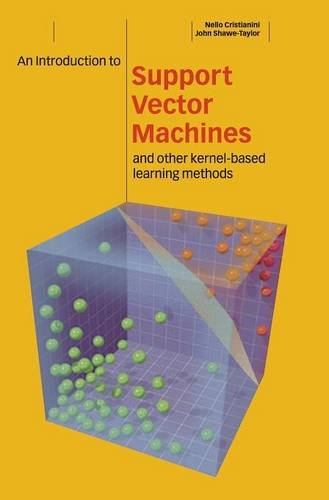An Introduction to Support Vector Machines and Other Kernel-based Learning Methods epub
Par green courtney le lundi, décembre 19 2016, 18:27 - Lien permanent
An Introduction to Support Vector Machines and Other Kernel-based Learning Methods by John Shawe-Taylor, Nello Cristianini


An Introduction to Support Vector Machines and Other Kernel-based Learning Methods John Shawe-Taylor, Nello Cristianini ebook
Format: chm
ISBN: 0521780195, 9780521780193
Page: 189
Publisher: Cambridge University Press
Both methods are suitable for further analyses using machine learning methods such as support vector machines, logistic regression, principal components analysis or prediction analysis for microarrays. According to Vladimir Vapnik in Statistical Learning Theory (1998), the assumption is inappropriate for modern large scale problems, and his invention of the Support Vector Machine (SVM) makes such assumption unnecessary. It includes two phases: Training phase: Learn a model from training data; Predicting phase: Use the model to predict the unknown or future outcome . Support vector machines are a relatively new classification or prediction method developed by Cortes and Vapnik21 in the 1990s as a result of the collaboration between the statistical and the machine-learning research communities. Predictive Analytics is about predicting future outcome based on analyzing data collected previously. Support Vector Machine (SVM) is a supervised learning algorithm developed by Vladimir Vapnik and his co-workers at AT&T Bell Labs in the mid 90's. Discrimination of IBD or IBS from CTRL based upon gene-expression ratios. "Boosting" is another approach in Ensemble Method. Search for optimal SVM kernel and parameters for the regression model of cadata using rpusvm based on similar procedures explained in the text A Practical Guide to Support Vector Classification. [1] An Introduction to Support Vector Machines and other kernel-based learning methods. Since their appearance in the early nineties, support vector machines and related kernel-based methods have been successfully applied in diverse fields of application such as bioinformatics, fraud detection, construction of insurance tariffs, direct marketing, and data and text As a consequence, SVMs now play an important role in statistical machine learning and are used not only by statisticians, mathematicians, and computer scientists, but also by engineers and data analysts. Nello Cristianini, John Shawer-Taylor [2] 数据挖掘中的新方法-支持向量机 邓乃扬, 田英杰 [3] 机器学习. [8] Nello Cristianini and John Shawe-Taylor, “An Introduction to Support Vector Machines and Other Kernel-based Learning Methods”, Cambridge University Press, 2000. Publicus Groupe SA, issued in February 2012, giving a judicial imprimatur to use of “predictive coding” and other sophisticated iterative sampling techniques in satisfaction of discovery obligations, should assist in paving the way toward greater acceptance of these new methods. Almost all of these machine learning processes are based on support vector machines or related algorithms, which at first glance seem unapproachably complex. We applied three separate analytic approaches; one utilized a scoring system derived from combinations of ratios of expression levels of two genes and two different support vector machines. A Support Vector Machine provides a binary classification mechanism based on finding a hyperplane between a set of samples with +ve and -ve outputs.